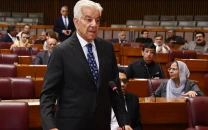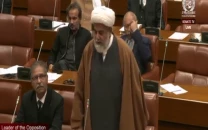Economy slips into stagflation: Pakistan posts meagre 0.29% GDP growth
Dar blames IMF ‘drama’ for undervalued rupee; rules out new deal; vows to restore macroeconomic stability

Pakistan’s economy slipped into stagflation -- having 0.3% economic growth with the 38% inflation rate -- during the outgoing fiscal year and there are no signs of an early recovery after Finance Minister Ishaq Dar on Thursday ruled out a new deal with the International Monetary Fund (IMF).
While launching the Pakistan Economic Survey 2022-23, Dar emphasised having a “Plan B” but he did not share its details.
The finance minister blamed the negative perception and loss of faith for an anaemic economic growth rate of 0.3% in the outgoing fiscal year -- a rate that was far lower than the target of 5%.
The lower growth also caused high unemployment and poverty at a time when the people braced the country's highest-ever inflation rate of 38% in May this year.
Dar took more than half an hour before he started sharing the macroeconomic figures for the outgoing fiscal year.
The coalition government of the 13 parties failed to achieve even a single major economic target during the outgoing fiscal year.
“Despite all the constraints, the GDP growth is 0.29%, which is a realistic achievement and it could not have been better than this,” Dar remarked while defending his government’s poor performance.
The 0.29% growth rate is the lowest increase in the national output in the past four years that exposes the mismanagement of the economy.
Similarly, the targets of restricting inflation to 11.5% and increasing investment as well as savings -- the three most important indicators -- were also missed by huge margins.
The finance minister hinted at increasing the salaries of the employees, equal to the average core inflation rate.
The core inflation – calculated after excluding energy and food prices – surged to 20% in urban areas and 26.9% in rural areas in May, according to the Pakistan Bureau of Statistics (PBS).
“We have [prevented] the default and also stopped the downward slide of the economy,” Dar replied when asked about any achievement of his government.
“There is a loss of faith and the people’s perception is negative [and that] pulls down the economy as well as the value of the rupee,” he added.
Dar maintained that because of the IMF “drama” and the negative perception, the rupee was undervalued by Rs45 against the US dollar.
While speaking about the government’s plans for the next fiscal year, the finance minister said his first priority was making sovereign payments and the rest of the business would come after it.
This suggests that the import restrictions will not ease in the coming months -- a terrible news for the industry as well as the wholesale and trade sectors.
“We have stopped the decline of the economy and prevented Pakistan from default[ing on its external repayments]. Now our objective is 3.5% growth for the next [fiscal] year,” Dar claimed.
The finance minister also cleared the air about the IMF programme, ruling out signing a new deal after the current programme expired on June 30.
Read PM approves plan for uplift of youth, farmers, women
“We need to be clear that the current IMF programme is scheduled to end on June 30,” Dar said in response to a question if the incumbent government’s plan included negotiating a new deal with the Washington-based lender amid calls for Pakistan’s need for another bailout package.
“We are hopeful that the ninth review will be completed successfully as it is necessary for Pakistan. After that, it will only be fair that it will be the prerogative of a new government, after elections, to negotiate any new programme with the IMF,” the country’s financial czar continued.
The talks for the ninth review have remained inconclusive since February this year.
The chances of revival of the programme before it expires in three weeks have almost ended.
“At this stage, it will be totally undemocratic and unfair to initiate negotiations on a new programme. Let whoever [wins the upcoming elections] be the one to decide. They shouldn’t be bound,” Dar maintained.
His statement suggests that any new IMF programme cannot be signed before November – a gap of at least five months that may create more uncertainty because of the low foreign exchange reserves standing at just $3.9 billion.
During his conversation with IMF Managing Director Kristalina Georgieva, Prime Minister Shehbaz Sharif had expressed his interest in negotiating a new deal with the global lender.
To another question, Dar said there was a “Plan B” in case there was no deal during the current review.
Last week, Minister of State for Finance Dr Aisha Pasha said there was no “Plan B”.
“We have a ‘Plan B’, if God forbid, we are dragged to a corner. We cannot allow ourselves to default,” the finance minister claimed.
Dar maintained that Pakistan was facing a liquidity crunch because of the “foolishness” of the previous government over the external account spending.
“Pakistan’s biggest problem remains the external sector,” he added.
The finance minister said the IMF programme, which was initiated in 2019, should have ended in 2022 but he did not comment on whether or not it was a wise decision to seek a nine-month extension.
Dar again spoke against the market-based exchange rate and absolute autonomy given to the central bank.
According to the finance minister, the exchange rate should be Rs244 to a dollar as per the Real Effective Exchange Rate (REER) matrix.
Reiterating that the rupee was undervalued, Dar stressed the need for addressing this issue.
“It is a vicious cycle and we are trapped in it,” Dar claimed, explaining why he “opposed” devaluation.
“Devaluation leads to high inflation and then subsequently monetary tightening through interest rates hike,” the finance minister elaborated.
Planning and Development Minister Ahsan Iqbal said 2023 was a financial year of “force majeure” because of the $50 billion trade deficit in the preceding period, unprecedented floods, and zero releases for development projects in the last quarter of the previous fiscal.
To another question, Dar said there was no quick fix.
“For a fair analysis, we have stopped the downward slide of the economy and the country did not become Sri Lanka despite all odds,” he continued.
The finance minister said he was against sharing the budget numbers with the IMF, but had done so only after a telephonic conversation between the prime minister and the lender’s managing director.
The Economic Survey showed that despite severe floods, the agricultural sector still posted 1.6% growth, beating all forecasts of contraction due to a devastating impact on crops.
The industrial sector contracted by 2.94%. However, the services sector – the single largest one in the economy – showed a nominal growth of 0.9%.
Read more Pakistan to leave 21% policy rate unchanged amid high inflation: analysts
The government has missed all sectoral targets because of its economic mismanagement that also caused massive layoffs and contributed towards the record 38% inflation rate.
The outgoing fiscal year will be marked in Pakistan’s history as the one when the country had experienced devastating floods that washed away crops, a highly mismanaged economy and a steep fall in the purchasing power of the people because of the spiralling inflation.
The government has inflicted heavy losses on the economy by devaluing the rupee and increasing the utility prices in the hope of reaching a deal with the IMF.
In the end, neither the IMF programme could be revived nor could the economy be saved from disaster.
The details showed that the massive curbs on imports and consumption pulled down the economic growth rate, which had already triggered a serious external sector crisis – an identical pattern witnessed in 2018 when the country fell into the lap of the IMF.
Last year, there was a 6.1% growth rate at the end of the PTI government’s tenure – the highest in four years.
The last time the country attained a 6.1% growth rate was in 2017-18 – the last year of the PML-N rule, which was also driven by consumption as well as imports and took the country back to the IMF.
During 2017-2018 and 2021-2022, Pakistan’s growth was largely financed through foreign savings, which is highly unsustainable.
Against the official target of attaining 3.9% growth rate, the farm sector is provisionally estimated to grow by 1.6%.
The floods washed away major crops that not only created food shortages but also wiped out people’s bread and butter.
The agricultural sector grew on the back of better crops of wheat (27.6 million tons) and sugarcane (9.1 million tons).
The industrial sector contracted 2.94% against the target of achieving 7.4% growth.
The government itself suffocated the industrial growth by placing curbs on imports that led to the shortage of raw materials and consequential closure of factories.
Still, the contraction appears less than the signs of a steep slowdown in major industries.
In the past fiscal year, the industrial sector grew 6.8%.
The State Bank of Pakistan also increased the interest rates to a record 21% in the hope of containing inflation.
However, the central bank is yet to rein in inflation that has already crossed the 36.4% mark.
The government had set the growth target for the services sector at 4% but according to provisional numbers, it showed a marginal growth of 0.9%.
In the previous fiscal year, the services sector had expanded to 6.6%.
Also read Pakistan needs convincing budget for any chance of more cash: IMF
Dar repeated that the PML-N had left Pakistan in a strong economic position in 2017, when he last served as the finance minister under party supremo Nawaz Sharif’s premiership.
The finance minister said he had previously championed a 3Es framework.
Dar added that it was now being expanded to a 5Es framework focusing on exports, equity, empowerment, environment and E-Pakistan (digital development).
“These are our five driving areas and we have made our roadmap for the next year based on them,” he explained.
The finance minister said the government’s biggest achievement was containing the current account deficit by 67% to $3.4 billion during July-March FY2023, against a deficit of $13 billion in the same period a year ago.
However, his critics say that the deficit was reduced by curbing the imports that crippled the industry.
“Pakistan was the 24th largest economy in 2017, but has now dropped to the 47th position,” Dar said.
“For the restoration of the economy, we have made a plan. Our objective is to restore macroeconomic stability, we need to bring it back to what it was in 2017,” he added.
The finance minister maintained that the economic downfall had stopped.
“We are working to restore economic activities now,” he continued.
























1733130350-0/Untitled-design-(76)1733130350-0-208x130.webp)









COMMENTS
Comments are moderated and generally will be posted if they are on-topic and not abusive.
For more information, please see our Comments FAQ